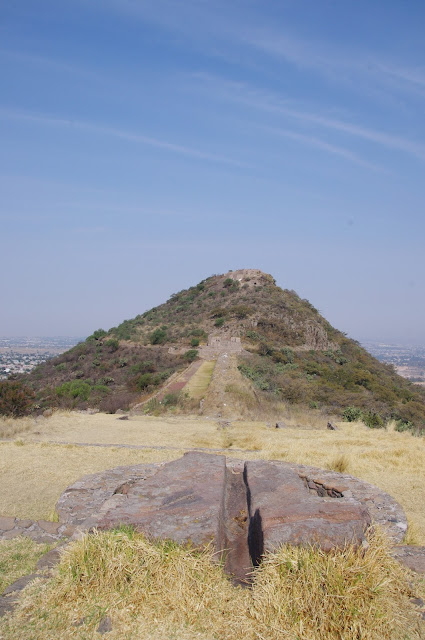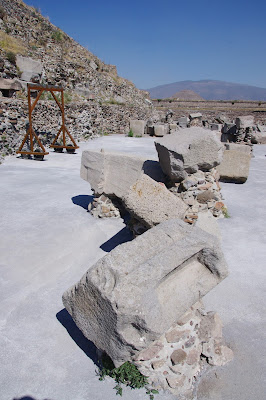Legends of the "Hall of Records"
 |
| The ancient site of Chalcatzingo from the air - perched between the two hills of Cerro Chalcatzingo (to the left) and Cerro Delgado (to the right) [Photo by Author] |
The search for the Mesoamerican hall
of records has led enthusiasts and independent researchers far into the forests
of Yucatan and Guatemala. The remote site of Piedras Negras, in present day
Guatemala, is often considered to be the most likely location of the elusive
Atlantean records, and has also been the subject of a recent DVD documentary
trying to demonstrate the existence of buried structures and an ancient cave
system at the site.
Arrival of the Gods
Ancient Mesoamerican traditions do
indeed describe the arrival of bearded, white-skinned “Gods” from across the Ocean,
the most famous being perhaps Quetzalcoatl. Just as in the Atlantean tradition,
these “Gods” were responsible for bringing the gifts of civilization to the savage
and yet uncivilized people of Mesoamerica. They were the inventor of writing
and the calendar, of monumental stone architecture and of all the arts and
sciences. Finally, they left, leaving behind a few of their race who would
later become the first divine kings of the Mayas and the Toltecs. Upon leaving,
the gods carried with them their sacred writings and their most prized relics. According
to another legend, they buried great treasures beneath the earth, in caves and
other secret places – so that they would one day recover them upon their
return.
 |
| The earliest known depiction of the feathered serpent in Mesoamerican Art, dating from 1,200-800 BC - from Monument 19 of La Venta (National Museum of Anthropology, Mexico City) [Photo by Author] |
The Olmecs were the first major
civilization in what is today Mexico and Guatemala, flourishing during a period
called by archaeologists the Formative Period of Mesoamerica, dating from 1,500
BC to 400 BC. The Olmec heartland was located in the tropical lowlands of the present-day
states of Veracruz and Tabasco, along the coast of the Gulf of Mexico.
The
Olmecs have left few, enigmatic monuments, the most famous being perhaps the
colossal stone heads unearthed during the 19th and 20th
century, together with some of the finest examples of stone sculpture in the
entire American continent.
Chalcatzingo
Chalcatzingo
represents an anomaly in Mesoamerican archaeology. For its location in the
Central highlands of Mexico, several hundred miles from the Olmec heartland, it
contains the most impressive set of Olmec monumental sculpture and rock art
anywhere outside of the Olmec capital at La Venta. It becomes immediately clear
that the exceptional importance of Chalcatzingo must have been predominantly of
a ritual or religious nature. The relatively small dimension of the formative
period settlement, hosting an estimate of between five hundred and a thousand
people, contrasts with the richness of the decorative art at the site and the
large number of sculptured stone monuments.
The ancient settlement is nestled in
a plain at the base of two high hills, the Cerro Chalcatzingo and the Cerro
Delgado. The largest groups of bas-reliefs is found on the cliff face and on
some large fallen stone boulders at the base of the Cerro Chalcatzingo, with
several others occurring on isolated stone slabs and stelae within the
ceremonial center proper.
 |
A closer view of the main ceremonial area from the air, against the backdrop of the Cerro Delgado [Photo by Author]
|
The most famous rock-cut monument at
Chalcatzingo, Monument no.1, is also known, as “El Rey”
– ‘The King´. It is found on a high rocky outcrop, less than a quarter of the
distance from the base of the Cerro Chalcatzingo. The bas-relief
depicts a crowned human-like figure, dressed ornately and sitting on a throne.
Most interestingly, the figure is placed inside a cave,
from which issue forth strange volutes of what might be wind or mist. The cave is shown in profile, and has the aspect of an open
mouth surmounted by an eye. Large clouds are pictured above the cave, with
exclamation-like (!) objects falling from them, together with what might be
interpreted as symbols for lightning or thunder. The seated figure inside the
cave carries a bundle of what appear to be scrolls.
The same cave is represented on
Monument no.9, this time from a frontal point of view. The cave has a
quatrefoil opening, with a large hole in the middle corresponding to the cave
entrance, above which are two eyes similar to the iconography of Monument no.1.
Another fragmentary monument (Monument
no. 13) at the base of the hill shows, in the remaining portion, the same cave
entrance with a figure, probably a priest, sitting inside it.
Two more monuments among the over 40
present on the site are interesting for the purpose of our research. One,
labelled Monument no. 21 depicts a woman in profile, standing next to a large
rectangular object of unknown significance. The object appears to be a large
pillar or obelisk, wrapped and covered in intricate designs. The object stands
on a kind of platform, to which it seems to be attached. The platform encloses
a square space with a diamond shape in the center and an opening in the middle.
A similar scene is also portrayed on Monument no.32, this time representing a
man mirroring the same gestures of the woman on Monument no. 21.
The monument marked no. 2, show a procession of elaborately clad personages wearing Olmec-style
masks. Three figures are standing, brandishing what could be maces or torches,
while a fourth figure is laying on the ground. This last figure is the most
interesting, for it appears to be bearded and carries an elaborate headdress.
It is unclear whether this is the depiction of a deceased or a bound prisoner.
A number of other carvings show
serpents, jaguars attacking men (curiously depicted with a beak, which gives
them the appearance of Gryphons, a subject otherwise unknown in Mesoamerican
art), and an equally curious representation of a man wearing a helmet, who is
either swimming or flying – attributes for which it has been aptly named “El Volador”.
 |
| The siting of some of the bas-reliefs on large boulders apparently fallen from the cliff-face of the Cerro Chalcatzingo in the background [Photo by Author] |
 |
| More of the curious rock carvings found on boulders around the base of the Cerro Chalcatzingo, believed to depict cosmogonical scenes related to the Creation of Man. [Photo by Author] |
A secret cavern?
For
the extreme importance attributed to sacred caves in Chalcatzingo art, not a single significant cave is known in the Cerro Chalcatzingo or the
neighboring Cerro Delgado. Both mountains represent singular geologic anomalies in an otherwise predominantly flat landscape. Their composition is a
reddish porphyry, extremely hard and compact. Seen from a distance, together
with the nearby Cerro del Chumil, they have the aspect of massive natural
pyramids rising almost unnaturally from the plains of Morelos.
Because of the type of rock of which
the Cerro Chalcatzingo and the nearby Cerro Delgado are composed, the presence
of natural caves in their interior is extremely unlikely. It is, however, the
peculiar way the cave entrance is depicted on the Chalcatzingo monuments and
rock carvings that suggests we may not here be dealing with a natural cavern,
but rather with an artificial tunnel or vault. The regular, quatrefoil shape of
the cavern mouth, together with the other depictions of what appears to be a square or rectangular enclosure, are suggestive of an artificial space rather
than a natural one.
The figure of “El Rey” depicted on Monument
no.1 sitting inside the cavern, further hints to the possibility that documents
of some sort, together with “scrolls” and other sacred relics might have been
buried inside the cavern. Additionally, the cave might have contained the
burial of a very high-ranking individual of the Olmec or pre-Olmec elite.
Another interesting parallel can be
drawn between the carvings representing men being attacked and killed by jaguars, the references to rain in the form of clouds with rain drops and lightning,
and the Mesoamerican creation myths. According to these early creation
accounts, humanity had suffered at least four previous destructions, in which
people were devoured by jaguars or drowned in a deluge. All of this seems to
find a parallel in the strange rock-carvings of Chalcatzingo, which, according
to several interpretations, might have been intended as an account of creation.
It is certainly suggestive to imagine
the cave, surmounted by ominous clouds, as a sort of antediluvian shelter where
documents and other artifacts were preserved from the
coming deluge by a previous human race.
The strange, almost ´technological´
aspect of some of the objects displayed on the bas-reliefs, particularly the
two bound pillars or obelisks portrayed on Monument no. 21 and on Monument no.
32, also seem to be related to the content of the cavern, particularly if the
square enclosure depicted at the base of both monuments and is to be interpreted as a stylized cave or Earth monster.
 |
| Artist rendition of Monument No.1 of Chalcatzingo, known as "El Rey". One can appreciate both the cave (seen in profile) and the clouds pouring rain from above. |
 |
| The carvings on Monument No. 2, depicting a procession of masked men carrying maces or torches and a bearded individual lying on the ground. |
Where, then, was this cavern located?
There are three possible locations
for the cave entrance, two on the Cerro Chalcatzingo itself, and one on the
nearby Cerro Delgado.
The most obvious location would be on
one side of the bas-relief known as “El Rey” or Monument no.1. There seem to be
several large boulders on this spot covering what might be the entrance to a
cavern, including parts of the bas-relief itself. The ground there is very
humid, which might suggest the presence of a natural water source. There is
moreover evidence of fairly recent excavations on the opposite side of the
trench in which the bas-reliefs are located. If a cave existed at this spot, it
has either collapsed or was covered by debris fallen from the cliff face in
ancient times.
 |
| The position of Monument No.1, known as "El Rey" (to the left of the picture), next to what could be the entrance of a collapsed cavern filled with large boulders. [Photo by Author] |
A final possibility is that the cave entrance could be located not on the Cerro Chalcatzingo, but on the nearby Cerro Delgado. Pictures of the cliff face taken with the aid of a drone, do indeed reveal what might be cave openings very near the summit, in a location of almost impossible access. What is most intriguing about these possible cave openings is that they are strongly reminiscent, under certain light conditions, of the eyes and mouth of a giant monstrous face. This might explain the eyes placed around the mouth of the cave on the Chalcatzingo bas-reliefs.
Could this be the
reason why the site was also chosen by the Olmecs for realizing one of their
most impressive settlements and artistic displays, so far from their cultural heartland
on the Gulf Coast of Mexico? More research will be needed to confirm the
existence of a cave entrance on the precise spot corresponding to the “mouth”
of the Earth monster carved on the face of the
Cerro Delgado.
The discovery of this cavern might
perhaps reveal more of the mysterious origins of the Olmec people and of
Mesoamerican civilization as a legacy of the “Gods”.
A drone fly-over of the ancient site of Chalcatzingo and the nearby Cerro Delgado [Video by Author]:
References:
[1] Chalcatzingo Archaeological Site –
From Wikipedia: https://en.wikipedia.org/wiki/Chalcatzingo
[2] David C. Grove, Ancient
Chalcatzingo, University of Texas Press, Austin, 1987 – Online resource:
http://www.famsi.org/research/grove/chalcatzingo/index.html
[3] Museum entry on Chalcatzingo, Morelos
– National Museum of Anthropology, Mexico City: http://www.mna.inah.gob.mx/coleccion/huellas-mna/anteriores/chalcatzingo-morelos.html



















































